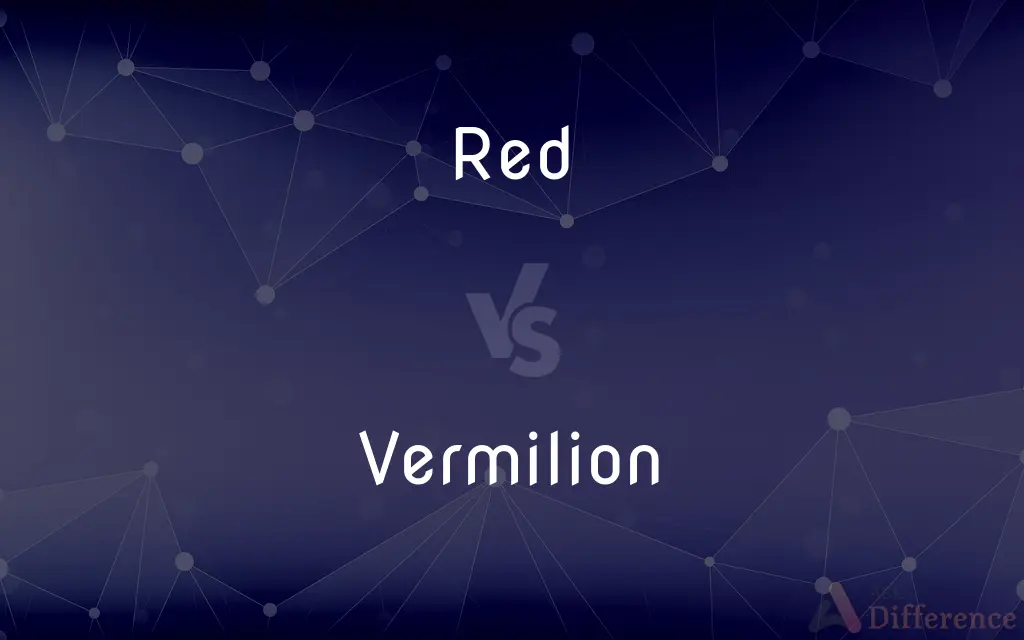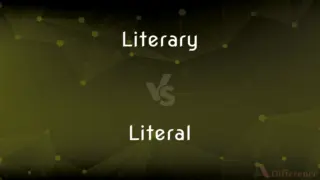Red vs. Vermilion — What's the Difference?
By Tayyaba Rehman & Maham Liaqat — Updated on April 3, 2024
Red is a primary color perceived when light with a wavelength of around 620–740 nm is present, while vermilion is a brilliant red or scarlet pigment originally made from the powdered mineral cinnabar.

Difference Between Red and Vermilion
Table of Contents
ADVERTISEMENT
Key Differences
Red is one of the three primary colors in the RGB (Red, Green, Blue) color model, used in painting and traditional color theory. It is a bold color often associated with passion, danger, and love. Red can have various shades, from deep burgundy to bright cherry. Vermilion, on the other hand, is a specific shade of red, with a warm, slightly orange undertone. Historically, vermilion was made from cinnabar and used in art and decoration for its vivid and enduring color. Today, vermilion refers not only to the pigment derived from cinnabar but also to a synthetic pigment created to mimic the original's hue.
The use of red is widespread and versatile, applicable in countless contexts, from fashion and branding to traffic lights and symbols of political or cultural significance. Vermilion, due to its specific hue and historical cost, is often reserved for special applications in art and decor that seek to capture its unique warmth and intensity.
In terms of symbolism, red carries a wide range of meanings across different cultures, from joy and prosperity to warning and prohibition. Vermilion, particularly in Chinese and Indian cultures, holds significant cultural value, symbolizing luck, health, and immortality. It is often used in religious and ceremonial contexts, highlighting its importance beyond just a color.
The distinction between red and vermilion in art and design lies in their application and the emotional or cultural responses they evoke. Red is a fundamental color choice that can be tailored to various needs and messages. In contrast, vermilion offers a specific historical and cultural richness, providing depth and warmth to artistic works and designs.
While all vermilion is red, not all reds can be considered vermilion. The specificity of vermilion lies in its particular shade and the historical and cultural significance carried by this vibrant pigment.
ADVERTISEMENT
Comparison Chart
Definition
A primary color visible in the spectrum around 620–740 nm.
A brilliant red pigment made from cinnabar.
Hue
Can vary widely within its spectrum.
Warm, with a slightly orange undertone.
Origin
Natural color, fundamental in the RGB color model.
Originally from powdered mineral cinnabar.
Uses
Broad and versatile across multiple domains.
Often reserved for art and special decor.
Symbolism
Varies widely, from passion to danger.
Associated with luck, health, and prosperity in some cultures.
Cultural Significance
Broad, depending on context and culture.
High, especially in Chinese and Indian traditions.
Cost
Generally low, given its ubiquity.
Historically expensive due to its natural sources.
Compare with Definitions
Red
A primary color seen in rainbows and sunsets.
The red sunset bathed the city in a warm glow.
Vermilion
Associated with cultural and historical significance.
Vermilion has been used in art and decoration for centuries, indicating its enduring appeal.
Red
Common in branding and marketing.
Many brands use red for its attention-grabbing quality.
Vermilion
Made historically from cinnabar.
Vermilion pigment was prized for its vividness in ancient art.
Red
Versatile in its symbolism.
Red roses are a universal symbol of love.
Vermilion
Symbolic in Eastern cultures.
Vermilion is used in ceremonies for good luck and health.
Red
Present in numerous shades.
She preferred wearing dark red to bright red.
Vermilion
A shade of red with an orange undertone.
The artist used vermilion to give warmth to the painting.
Red
Symbol of passion and danger.
Red often signifies stop or danger in traffic signals.
Vermilion
Reserved for specific artistic applications.
Vermilion ink is used in traditional calligraphy.
Red
Red is the color at the long wavelength end of the visible spectrum of light, next to orange and opposite violet. It has a dominant wavelength of approximately 625–740 nanometres.
Vermilion
Vermilion (sometimes spelled vermillion) is both a brilliant red or scarlet pigment, originally made from the powdered mineral cinnabar, and the corresponding color. It is commonly used in Hindu culture, primarily by women, and was widely used in the art and decoration of Ancient Rome, in the illuminated manuscripts of the Middle Ages, in the paintings of the Renaissance, and in the art and lacquerware of China.
Red
A pigment or dye having a red hue.
Vermilion
A brilliant red pigment made from mercury sulphide (cinnabar).
Red
Something that has a red hue.
Vermilion
A vivid red to reddish orange. Also called Chinese red, cinnabar.
Red
Often Red A Communist.
Vermilion
See mercuric sulfide.
Red
A revolutionary activist.
Vermilion
Of a vivid red to reddish orange.
Red
The condition of being in debt or operating at a loss
The firm has been in the red all year.
Vermilion
To color or dye (something) in the hue vermilion.
Red
Reddish in color or having parts that are reddish in color
A red dog.
A red oak.
Vermilion
A vivid red synthetic pigment made of mercury sulfide, cinnabar.
Red
Having a reddish or coppery skin color.
Vermilion
A bright orange-red colour.
Red
Often Red Often Offensive Of or being a Native American.
Vermilion
A type of red dye worn in the parting of the hair by married Hindu women.
Red
Having a ruddy or flushed complexion
Red with embarrassment.
Vermilion
The red skin of the lips or its border with the skin of the face.
Red
Relating to or being a red state.
Vermilion
(obsolete) The kermes or cochineal insect.
Red
Often Red Communist.
Vermilion
(obsolete) The cochineal dye made from this insect.
Red
Having red#Noun as its color.
The girl wore a red skirt.
Vermilion
Having a brilliant red colour.
Red
(of hair) Having an orange-brown or orange-blond colour; ginger.
Her hair had red highlights.
Vermilion
Having the color of the vermilion dye.
Red
(of the skin) With a red hue due to embarrassment or sunburn.
Vermilion
(transitive) To color or paint vermilion.
Red
Of the hearts or diamonds suits. Compare of the spades or clubs suits
I got two red queens, and he got one of the black queens.
Vermilion
A bright red pigment consisting of mercuric sulphide, obtained either from the mineral cinnabar or artificially. It has a fine red color, and is much used in coloring sealing wax, in printing, etc.
Red
Supportive of, related to, or dominated by a political party or movement represented by the color red:
Vermilion
Hence, a red color like the pigment; a lively and brilliant red; as, cheeks of vermilion.
Red
Left-wing parties and movements, chiefly socialist or communist, including the U.K. Labour party and the Social Democratic Party of Germany.
The red-black grand coalition in Germany
Vermilion
To color with vermilion, or as if with vermilion; to dye red; to cover with a delicate red.
Red
(US politics) The U.S. Republican Party.
A red state
A red Congress
Vermilion
A variable color that is vivid red but sometimes with an orange tinge
Red
Amerind; relating to Amerindians or First Nations
Vermilion
Color vermilion
Red
(astronomy) Of the lower-frequency region of the (typically visible) part of the electromagnetic spectrum which is relevant in the specific observation.
Vermilion
Of a vivid red to reddish-orange color
Red
(particle physics) Having a color charge of red.
Red
(countable) A revolutionary socialist or (most commonly) a Communist; usually capitalized a Bolshevik, a supporter of the Bolsheviks in the Russian Civil War.
Red
One of the 15 red balls used in snooker, distinguished from the colours.
Red
Red wine.
Red
(countable) Any of several varieties of ale which are brewed with red or kilned malt, giving the beer a red colour.
Red
A red kangaroo.
Red
A redshank.
Red
An American Indian.
Red
(slang) The drug secobarbital; a capsule of this drug.
Red
(informal) A red light a traffic signal
Red
(particle physics) One of the three color charges for quarks.
Red
Usually in the phrase "bowl of red".
Red
(informal) The redfish or red drum, Sciaenops ocellatus, a fish with reddish fins and scales.
Red
Tomato ketchup.
Red
(archaic) rede
Red
To put on order; to make tidy; also, to free from entanglement or embarrassement; - generally with up; as, to red up a house.
Red
A red pigment.
Red
The menses.
Red
A tributary of the Mississippi River that flows eastward from Texas along the southern boundary of Oklahoma and through Louisiana
Red
Emotionally charged terms used to refer to extreme radicals or revolutionaries
Red
The amount by which the cost of a business exceeds its revenue;
The company operated at a loss last year
The company operated in the red last year
Red
(especially of the face) reddened or suffused with or as if with blood from emotion or exertion;
Crimson with fury
Turned red from exertion
With puffy reddened eyes
Red-faced and violent
Flushed (or crimson) with embarrassment
Common Curiosities
How is vermilion used in culture?
In cultures such as Chinese and Indian, vermilion is used in religious and ceremonial contexts, symbolizing luck, health, and prosperity.
Can vermilion be considered a type of red?
Yes, vermilion is considered a type of red, specifically known for its brilliant, warm hue.
Why was vermilion historically expensive?
Vermilion was expensive due to its production from the rare mineral cinnabar and the complex process required to make the pigment.
What is the difference between red and vermilion?
Red is a primary color with a broad spectrum, while vermilion is a specific shade of red with a warm, slightly orange undertone.
Why is vermilion special?
Vermilion is special because of its historical use as a vivid pigment made from cinnabar, and its cultural significance in certain traditions.
Is all red paint made from cinnabar?
No, not all red paint is made from cinnabar. Vermilion is specifically associated with cinnabar, but there are many synthetic and natural red pigments.
How do artists choose between red and vermilion?
Artists choose based on the desired shade, warmth, and emotional or cultural impact they wish to convey in their work.
Are there synthetic alternatives to vermilion?
Yes, there are synthetic alternatives that mimic the color of vermilion without the use of cinnabar.
What makes vermilion unique compared to other reds?
Vermilion's unique warmth, slightly orange undertone, and its historical and cultural significance make it distinct among reds.
What does red symbolize?
Red can symbolize a range of emotions and concepts, including passion, danger, love, and urgency, depending on the context.
Share Your Discovery

Previous Comparison
Fabric vs. Material
Next Comparison
Literary vs. LiteralAuthor Spotlight
Written by
Tayyaba RehmanTayyaba Rehman is a distinguished writer, currently serving as a primary contributor to askdifference.com. As a researcher in semantics and etymology, Tayyaba's passion for the complexity of languages and their distinctions has found a perfect home on the platform. Tayyaba delves into the intricacies of language, distinguishing between commonly confused words and phrases, thereby providing clarity for readers worldwide.
Co-written by
Maham Liaqat















































